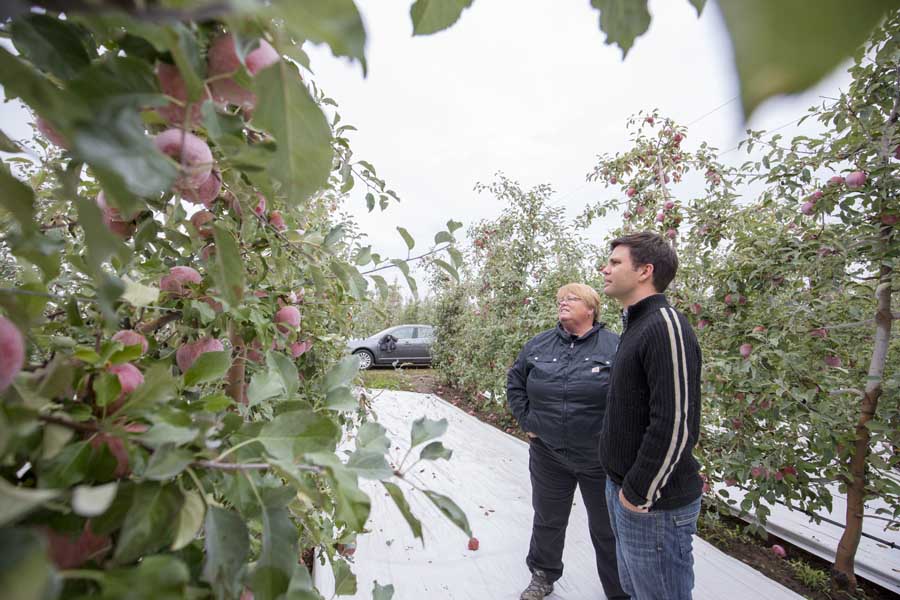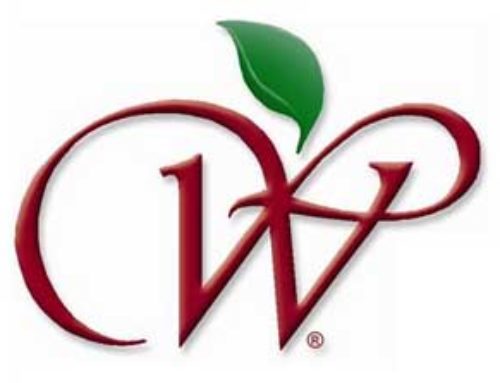
Karen Lewis, WSU tree fruit regional extension specialist, gives Rob Blakey, the extension’s most recent hire, a tour of several orchards around Pasco, Washington, in mid-October. TJ Mullinax/Good Fruit Grower
Orchards and packing houses aren’t the only places in the fruit industry with a labor shortage. Universities also are struggling to hire researchers and educators needed to keep the industry ahead of pest pressures, prepared for food safety requirements, growing new varieties and in tune with emerging technology.
That requires people with a high level of training and expertise to carry the industry to the future. Such people can be hard to come by.
This is playing out at Washington State University, where, nearly four years after tree fruit growers gave the college its largest donation ever, the university is still working to fill positions the $32 million gift helped create.
But there’s progress there, too: The latest hire, a tree fruit extension specialist in postharvest information and technology transfer, started in August.
In 2013, the state’s fruit growers promised the funds to help create one of the top three tree fruit universities in the world by improving facilities and hiring top researchers and extension specialists. The effort was designed to make up for shrinking state and county budgets that have whittled away extension programs and keep up with the growing complexity, sophistication and competition of the global fruit industry for the coming decades. Orchardists across the nation are making similar moves by creating commissions and directly funding university research.
So far at Washington State University, two people have been hired out of upward of more than a dozen positions created by the endowment, while half of the promised money has been collected. Growers make their endowment payments through assessments, a self-imposed tax approved by a vote, collected at the time of packing. Rates differ by commodity. The university has collected $16 million of the full $32 million endowment.
The process is by necessity slow, said Sam Godwin, a Tonasket grower and member of the Endowment Advisory Committee. For one thing, the university is seeking only the top qualified job candidates with the highest level of specialization in the world. They’re hard to find and lure, especially with other fruit regions vying for the same people.
“We’re fishing in very shallow water,” he said.
Meanwhile, as a state agency, the university’s hiring process is slow, while the candidates and their spouses sometimes have research projects they need to finish before moving to Washington. Also, the endowment is intended to create a perpetual fund, paying some salaries and operating costs only with interest earned from the principal donation. Interest takes time to accrue. And visa applications for international hires can take months.
However, once the university starts hiring, the endowment provides a strong recruiting tool.
“The endowment definitely made an impression on me when I applied for the position,” Rob Blakey, the most recent hire, said in an email. “A researcher or extension officer can do so much more when there is support from the industry; $32 million is serious support of research and extension in general and WSU in particular.”
Based at the university’s Irrigated Agriculture Research and Extension Center in Prosser, Washington, Blakey spent most of his early days just getting to know the industry’s needs. He is now working on project proposals to develop a statewide extension program, identifying handling steps that cause fruit quality loss and developing modern educational programs and resources, such as defect guides, podcasts and online videos. He is specifically interested in improving pear ripening; he focused on ripening at his previous position as a research horticulturist in the avocado industry in South Africa.
The only other endowment-related, full-time hire so far has been Stefano Musacchi, the first endowed chair, one of six such positions created by the endowment. The endowment title got his attention, too, he said.
“From the academic point of view, it is the highest academic award that the university can bestow on a faculty member,” he said in an email. “Endowed faculty professorships and chairs are fundamental for recruiting and retaining the highest-quality faculty.”
Musacchi, a research horticulturist specializing in physiology and management at the Tree Fruit Research and Extension Center in Wenatchee, started in 2013. He leads the effort to educate growers on the horticulture of Cosmic Crisp, the university’s new apple variety, and manages the national NC-140 Apple Rootstock Evaluation project. He also is leading a research effort to recommend new varieties of apple pollinator trees based on pollen compatibility.
The endowment has provided seed money for Musacchi’s work with the Cosmic Crisp and a preliminary apple rootstock study that helped him land a Specialty Crop Research Initiative grant for more than $400,000 to take the research further. It’s called “Accelerating the Development, Evaluation, and Adoption of New Apple Rootstock Technologies to Improve Apple Grower Profitability and Sustainability.” In all, Musacchi is the principal investigator or co-principal investigator of projects with a collective value of more than $7.5 million.
Endowed researchers also are able to attract collaborators, like Musacchi already has. He is organizing a 2020 International Society for Horticultural Science symposium in Wenatchee named “Integrating Canopy, Rootstock and Environmental Physiology in Orchard Systems.” The Belgium-based group, one of the leading horticultural science organizations in the world, holds this large symposium once every four years and has been in the United States only twice — Wenatchee hosted in 1996 and Geneva, New York, in 2008.
Structure of the endowment
The endowment is divided into three sections: Endowed chairs, extension information and technology transfer, and research facilities and operations. They all work a little differently.
A total of $12 million of the endowment is allocated for the work of six endowed chairs, including Musacchi. The university pays the salaries, benefits and moving costs of the endowed chairs, while the interest from the endowment covers the cost of their projects, such as laboratory equipment, travel or hiring graduate students as assistants. Searches for an endowed chair of soil and rhizosphere ecology and a chair for postharvest systems are underway, while other potential areas of specialty for future endowed chairs may be engineering, automation and molecular biology. The chair slots are funded for up to $2.5 million. Musacchi’s is at $1.5 million. Assuming 4 percent interest, that funding would provide him $300,000 in seed money over five years, the term of his position, available quarterly as long as the investments perform positively. If they don’t, the money freezes until the original value is restored. The university has the option of renewing his endowment after five years, though a review could come anytime, he said.
Another $12 million goes to information and technology transfer. The endowment interest directly pays for the salaries in this category, such as extension specialists like Blakey, web designers and others. Their jobs involve taking the conclusions of the endowed chairs and getting them into the hands of growers, packers, field representatives and supply chain representatives. Other outreach areas of expertise in the future may include food safety, integrated pest management, entomology and web development, to name a few. The position of tree fruit team leader also is on the slate and is currently filled on an interim basis by Karen Lewis, though hers is not an endowment position.
That leaves $8 million for research operations, which may mean improving orchards and facilities. For example, the university could use the interest from that portion of the endowment money to put wind machines or netting in a research orchard.
Activities of the endowment are governed by the university’s College of Agricultural, Human and Natural Resource Sciences and the Endowment Advisory Committee, a group of growers that meets four times a year. The committee takes a direct role in overseeing the work, too. The endowed chairs face an annual review from both the university and the committee.
“This certainly increases the pressure on my shoulders,” Musacchi said.
Throughout the nation, crop industries often ante up for researchers and research projects. The tree fruit industry’s endowment was the first to set up such a three-pronged approach, Godwin said. The structure allows flexibility to move money around and gives the researchers and extension staffers the ability to use endowment funds to attract other grants by proving the industry has skin in the game and guarantees seed money each funding cycle.
In short, it gives growers some ownership of the university’s work.
“It’s great to have a partner who is willing to vote with money,” Godwin said.






Leave A Comment